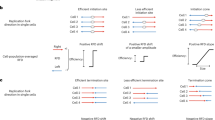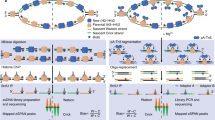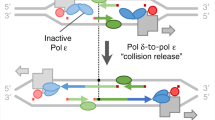Abstract
Fifty per cent of the genome is discontinuously replicated on the lagging strand as Okazaki fragments. Eukaryotic Okazaki fragments remain poorly characterized and, because nucleosomes are rapidly deposited on nascent DNA, Okazaki fragment processing and nucleosome assembly potentially affect one another. Here we show that ligation-competent Okazaki fragments in Saccharomyces cerevisiae are sized according to the nucleosome repeat. Using deep sequencing, we demonstrate that ligation junctions preferentially occur near nucleosome midpoints rather than in internucleosomal linker regions. Disrupting chromatin assembly or lagging-strand polymerase processivity affects both the size and the distribution of Okazaki fragments, suggesting a role for nascent chromatin, assembled immediately after the passage of the replication fork, in the termination of Okazaki fragment synthesis. Our studies represent the first high-resolution analysis—to our knowledge—of eukaryotic Okazaki fragments in vivo, and reveal the interconnection between lagging-strand synthesis and chromatin assembly.
This is a preview of subscription content, access via your institution
Access options
Subscribe to this journal
Receive 51 print issues and online access
$199.00 per year
only $3.90 per issue
Buy this article
- Purchase on Springer Link
- Instant access to full article PDF
Prices may be subject to local taxes which are calculated during checkout





Similar content being viewed by others
Accession codes
Primary accessions
Gene Expression Omnibus
Data deposits
Raw sequencing data and processed data are available at theGene Expression Omnibus (http://www.ncbi.nlm.nih.gov/geo/query/acc.cgi?acc=GSE33786) under accession number 33786.
References
Corpet, A. & Almouzni, G. Making copies of chromatin: the challenge of nucleosomal organization and epigenetic information. Trends Cell Biol. 19, 29–41 (2009)
Sogo, J. M., Stahl, H., Koller, T. & Knippers, R. Structure of replicating simian virus 40 minichromosomes. The replication fork, core histone segregation and terminal structures. J. Mol. Biol. 189, 189–204 (1986)
Burgers, P. M. Polymerase dynamics at the eukaryotic DNA replication fork. J. Biol. Chem. 284, 4041–4045 (2009)
Kaufmann, G. & Falk, H. H. An oligoribonucleotide polymerase from SV40-infected cells with properties of a primase. Nucleic Acids Res. 10, 2309–2321 (1982)
Nethanel, T. & Kaufmann, G. Two DNA polymerases may be required for synthesis of the lagging DNA strand of simian virus 40. J. Virol. 64, 5912–5918 (1990)
Waga, S. & Stillman, B. Anatomy of a DNA replication fork revealed by reconstitution of SV40 DNA replication in vitro. Nature 369, 207–212 (1994)
Ayyagari, R., Gomes, X. V., Gordenin, D. A. & Burgers, P. M. Okazaki fragment maturation in yeast. I. Distribution of functions between FEN1 and DNA2. J. Biol. Chem. 278, 1618–1625 (2003)
Bae, S. H., Bae, K. H., Kim, J. A. & Seo, Y. S. RPA governs endonuclease switching during processing of Okazaki fragments in eukaryotes. Nature 412, 456–461 (2001)
Kao, H. I., Veeraraghavan, J., Polaczek, P., Campbell, J. L. & Bambara, R. A. On the roles of Saccharomyces cerevisiae Dna2p and Flap endonuclease 1 in Okazaki fragment processing. J. Biol. Chem. 279, 15014–15024 (2004)
Garg, P., Stith, C. M., Sabouri, N., Johansson, E. & Burgers, P. M. Idling by DNA polymerase δ maintains a ligatable nick during lagging-strand DNA replication. Genes Dev. 18, 2764–2773 (2004)
Johnston, L. H. & Nasmyth, K. A. Saccharomyces cerevisiae cell cycle mutant cdc9 is defective in DNA ligase. Nature 274, 891–893 (1978)
Pavlov, Y. I. et al. Evidence that errors made by DNA polymerase α are corrected by DNA polymerase δ. Curr. Biol. 16, 202–207 (2006)
Anderson, S. & DePamphilis, M. L. Metabolism of Okazaki fragments during simian virus 40 DNA replication. J. Biol. Chem. 254, 11495–11504 (1979)
Bielinsky, A. K. & Gerbi, S. A. Discrete start sites for DNA synthesis in the yeast ARS1 origin. Science 279, 95–98 (1998)
Blumenthal, A. B. & Clark, E. J. Discrete sizes of replication intermediates in Drosophila cells. Cell 12, 183–189 (1977)
Dohmen, R. J. & Varshavsky, A. Heat-inducible degron and the making of conditional mutants. Methods Enzymol. 399, 799–822 (2005)
Bielinsky, A. K. & Gerbi, S. A. Chromosomal ARS1 has a single leading strand start site. Mol. Cell 3, 477–486 (1999)
Ng, P. et al. Gene identification signature (GIS) analysis for transcriptome characterization and genome annotation. Nature Methods 2, 105–111 (2005)
Nieduszynski, C. A., Hiraga, S., Ak, P., Benham, C. J. & Donaldson, A. D. OriDB: a DNA replication origin database. Nucleic Acids Res. 35, D40–D46 (2007)
Eaton, M. L., Galani, K., Kang, S., Bell, S. P. & MacAlpine, D. M. Conserved nucleosome positioning defines replication origins. Genes Dev. 24, 748–753 (2010)
Jiang, C. & Pugh, B. F. A compiled and systematic reference map of nucleosome positions across the Saccharomyces cerevisiae genome. Genome Biol. 10, R109 (2009)
Whitehouse, I., Rando, O. J., Delrow, J. & Tsukiyama, T. Chromatin remodelling at promoters suppresses antisense transcription. Nature 450, 1031–1035 (2007)
Hartley, P. D. & Madhani, H. D. Mechanisms that specify promoter nucleosome location and identity. Cell 137, 445–458 (2009)
Badis, G. et al. A library of yeast transcription factor motifs reveals a widespread function for Rsc3 in targeting nucleosome exclusion at promoters. Mol. Cell 32, 878–887 (2008)
MacIsaac, K. D. et al. An improved map of conserved regulatory sites for Saccharomyces cerevisiae. BMC Bioinformatics 7, 113 (2006)
Hall, M. A. et al. High-resolution dynamic mapping of histone–DNA interactions in a nucleosome. Nature Struct. Mol. Biol. 16, 124–129 (2009)
Bondarenko, V. A. et al. Nucleosomes can form a polar barrier to transcript elongation by RNA polymerase II. Mol. Cell 24, 469–479 (2006)
Churchman, L. S. & Weissman, J. S. Nascent transcript sequencing visualizes transcription at nucleotide resolution. Nature 469, 368–373 (2011)
Bai, L., Ondracka, A. & Cross, F. R. Multiple sequence-specific factors generate the nucleosome-depleted region on CLN2 promoter. Mol. Cell 42, 465–476 (2011)
Shibahara, K. & Stillman, B. Replication-dependent marking of DNA by PCNA facilitates CAF-1-coupled inheritance of chromatin. Cell 96, 575–585 (1999)
Johansson, E., Garg, P. & Burgers, P. M. The Pol32 subunit of DNA polymerase δ contains separable domains for processive replication and proliferating cell nuclear antigen (PCNA) binding. J. Biol. Chem. 279, 1907–1915 (2004)
Stith, C. M., Sterling, J., Resnick, M. A., Gordenin, D. A. & Burgers, P. M. Flexibility of eukaryotic Okazaki fragment maturation through regulated strand displacement synthesis. J. Biol. Chem. 283, 34129–34140 (2008)
Dong, F. & van Holde, K. E. Nucleosome positioning is determined by the (H3–H4)2 tetramer. Proc. Natl Acad. Sci. USA 88, 10596–10600 (1991)
Smith, S. & Stillman, B. Stepwise assembly of chromatin during DNA replication in vitro. EMBO J. 10, 971–980 (1991)
Chafin, D. R., Vitolo, J. M., Henricksen, L. A., Bambara, R. A. & Hayes, J. J. Human DNA ligase I efficiently seals nicks in nucleosomes. EMBO J. 19, 5492–5501 (2000)
Huggins, C. F. et al. Flap endonuclease 1 efficiently cleaves base excision repair and DNA replication intermediates assembled into nucleosomes. Mol. Cell 10, 1201–1211 (2002)
Ray-Gallet, D. et al. Dynamics of histone H3 deposition in vivo reveal a nucleosome gap-filling mechanism for H3.3 to maintain chromatin integrity. Mol. Cell 44, 928–941 (2011)
Zhang, Z., Shibahara, K. & Stillman, B. PCNA connects DNA replication to epigenetic inheritance in yeast. Nature 408, 221–225 (2000)
Groth, A. et al. Regulation of replication fork progression through histone supply and demand. Science 318, 1928–1931 (2007)
Hoek, M. & Stillman, B. Chromatin assembly factor 1 is essential and couples chromatin assembly to DNA replication in vivo. Proc. Natl Acad. Sci. USA 100, 12183–12188 (2003)
Murakami, H., Borde, V., Nicolas, A. & Keeney, S. Gel electrophoresis assays for analyzing DNA double-strand breaks in Saccharomyces cerevisiae at various spatial resolutions. Methods Mol. Biol. 557, 117–142 (2009)
Kaplan, N. et al. The DNA-encoded nucleosome organization of a eukaryotic genome. Nature 458, 362–366 (2009)
Acknowledgements
We thank S. McGuffee for assistance with data processing; S. Keeney, K. Marians, D. Remus, T. Tsukiyama, members of the Molecular Biology Program and Whitehouse laboratory for discussions and comments on the manuscript. This work was supported by a Louis V. Gerstner Jr Young Investigator Award and an Alfred Bressler Scholars Endowment Award to I.W. D.J.S. is an HHMI fellow of the Damon Runyon Cancer Research Foundation (DRG-#2046-10).
Author information
Authors and Affiliations
Contributions
D.J.S. and I.W. designed experiments; D.J.S. performed experiments and analysed data; D.J.S. and I.W. interpreted results; the manuscript was drafted by D.J.S. and edited by D.J.S. and I.W.
Corresponding author
Ethics declarations
Competing interests
The authors declare no competing financial interests.
Supplementary information
Supplementary Information
This file contains Supplementary Figures 1-11, Supplementary Table 1 and additional references. (PDF 1469 kb)
Rights and permissions
About this article
Cite this article
Smith, D., Whitehouse, I. Intrinsic coupling of lagging-strand synthesis to chromatin assembly. Nature 483, 434–438 (2012). https://doi.org/10.1038/nature10895
Received:
Accepted:
Published:
Issue Date:
DOI: https://doi.org/10.1038/nature10895
This article is cited by
-
Establishment and function of chromatin organization at replication origins
Nature (2023)
-
Unchanged PCNA and DNMT1 dynamics during replication in DNA ligase I-deficient cells but abnormal chromatin levels of non-replicative histone H1
Scientific Reports (2023)
-
Efficient and strand-specific profiling of replicating chromatin with enrichment and sequencing of protein-associated nascent DNA in mammalian cells
Nature Protocols (2021)
-
High-fidelity DNA ligation enforces accurate Okazaki fragment maturation during DNA replication
Nature Communications (2021)
-
Hepatitis B virus cccDNA is formed through distinct repair processes of each strand
Nature Communications (2021)
Comments
By submitting a comment you agree to abide by our Terms and Community Guidelines. If you find something abusive or that does not comply with our terms or guidelines please flag it as inappropriate.



